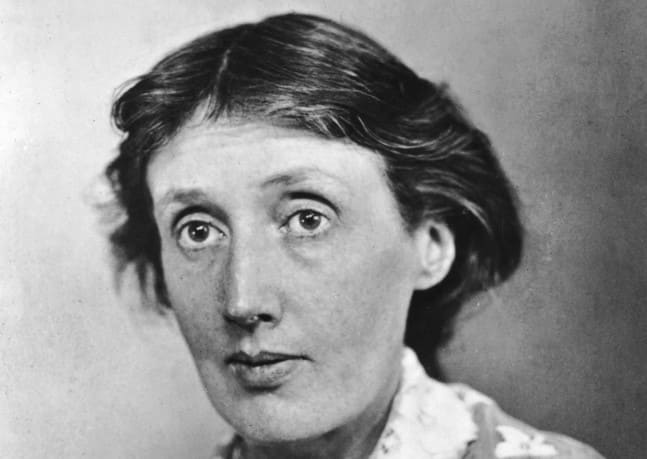Virginia Woolf was an English writer, publisher and social critic. Virginia Woolf became internationally famous with her novels and is still one of the most influential essayists on the subject of the women’s movement.
Early strokes of fate in Virginia Woolf’s youth
Virginia Woolf was born Adeline Virginia Stephen on January 25, 1882 in London. She grew up with eight siblings and half-siblings. Even as a young girl, Virginia was interested in books and literature, having access to her father’s large library. However, she did not enjoy schooling.
When Virginia was thirteen her mother died; nine years later, in 1904, her father also died. Both tragedies plunged Virginia into depression and she suffered mental breakdowns that she found difficult to overcome.
Bloomsbury Group and marriage to Leonard Woolf
She co-founded the Bloomsbury Group the same year her father died. The group brought together many artists, scientists and writers, and most notably enabled Virginia and two other women to break free from the moral bonds of Victorian restraint by being able to actively participate in community activities and express their opinions.
In addition, the Bloomsbury Group offered the opportunity to deal with modern English and American literature. In the years that followed, Virginia pursued her desire to become a writer. She began writing articles and book reviews for newspapers including The Times Literary Supplement and The Guardian. She also taught at Morley College.
In 1912 Virginia married the writer Leonard Sidney Woolf. She again suffered from mental disorders that affected her so badly that she attempted suicide in September of the same year.
Lifelong mental breakdowns
Virginia Woolf was plagued by depression and breakdowns her entire life. Why she kept getting sick remained unclear until her death. So far, her mental illnesses can be explained by the early blows of fate and abuse by her half-brothers. Despite her serious illness, Virginia Woolf managed to get her first novel, The Voyage Out, published in 1915 to positive public acclaim.
Two years later she founded her own publishing house with her husband, “The Hogarth Press”, which published all her other works, but also works by other writers. Little by little Virginia Woolf’s novels were published in the following years and she gained more and more fame and respect.
In 1936 she finished her novel The Waves, but soon fell ill again. A year later her critical work The Three Guineas was published.
Virginia Woolf did not get her recurring mental illnesses and breakdowns under control until the end of her life. She suffered too much from her early childhood strokes of fate. On March 28, 1941, Virginia Woolf drowned herself in the River Ouse in the town of Sussex, where she and her husband had moved in 1919. Her last novel, Between the Acts, was published posthumously shortly thereafter.
Influence of works
In the 1970s, letters, diaries and essays by Virginia Woolf were discovered and public attention returned to the writer, especially her feminist writings. The 1929 essay “A Room of One’s Own” is considered one of the most important and most cited texts of the new women’s movement.
Virginia Woolf was not only a writer, but also an essayist, publisher and critic. In her novels she dealt mainly with human consciousness and the psyche and tried to fathom them. In addition, in her late work “The Three Guineas” she criticized the patriarchal social order and linked it to the then emerging militarism and war.
To this day, Virginia Woolf is widely discussed and quoted, especially when it comes to gender studies and feminism.
What is Virginia Woolf most known for?
Virginia Woolf (1882–1941) is recognised as one of the most innovative writers of the 20th century. Perhaps best known as the author of Mrs Dalloway (1925) and To the Lighthouse (1927), she was also a prolific writer of essays, diaries, letters and biographies.
How did Virginia Woolf change the world?
Virginia Woolf, the pioneering female novellist, who was born on January 25 1882, till date is remembered to be one of the most bold modernist classic writers as she raised the question of why women can not be independent. Given the era she comes from, women were always taught to be submissive in nature.
What happened Virginia Woolf?
After a lifelong struggle with her mental health, including periods of severe depression and suicide attempts, Woolf died in 1941 by drowning herself near her house in Sussex, England, at the age of 59. As TIME noted in her obituary, she left behind a body of work that was complex and lyrical.
Who is Virginia Woolf feminism?
By India Today Web Desk: Virginia Woolf, the much-admired English writer and a pioneer of feminism and modernism, was born on January 25, 1882, as Adeline Virginia Stephen. Woolf became a prominent personality in the English literary spectrum in the years between the two World Wars.
What inspired Virginia Woolf to feminist?
How the theory of Feminism influenced Virginia as an adolescent. The relationship between her parents, the talented and highly respected Leslie Stephen and his beautiful wife, who was always there to give him support and her unshared attention, had great effect on Virginia’s attitude towards men.
Is Virginia Woolf a liberal feminist?
Through examination of laws and practices, liberal feminists including Mary Astell (1666–1731), Mary Wollstonecraft (1759–99), Harriet Taylor (1807–58), John Stuart Mill (1806–73), Elizabeth Cady Stanton (1815–1902), and Virginia Woolf (1882–1941) drew on the liberal tradition’s value of equality and individual freedom.
What are the 4 types of feminism?
There are four types of Feminism – Radical, Marxist, Liberal, and Difference.
What do you mean by black feminism?
Black feminism, however, centers on the experiences of African American women, understanding intersectionality between racism, sexism, and classism, as well as other social identities. Black feminism highlights and engages with the many aspects of racial inequities along with gender inequality.
What does Virginia Woolf mean by patriarchy?
It refers to the system of male domination. over women in society. This domination takes different forms: discrimination, disregard, insult, control, exploitation, or violence. Patriarchy does not survive on its own.





